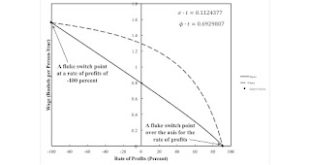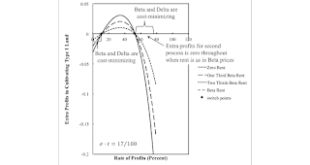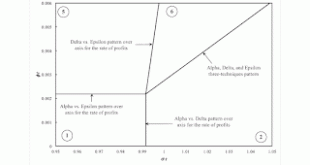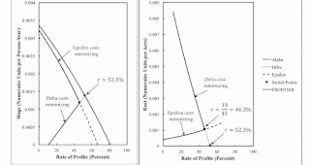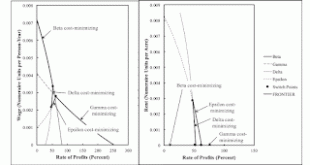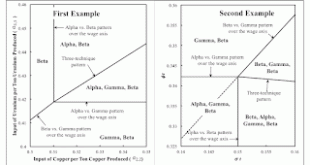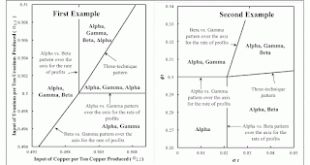Figure 1: A Wage Frontier With Two Fluke Switch Points This post presents an example with circulating capital alone. Table 1 presents the technology for an economy in which two commodities, iron and corn, are produced. One process is known for producing iron, and two are known for producing corn. Each process is specified by coefficients of production, that is, the required inputs per unit output. The Alpha technique consists of the iron-producing process and the first corn-producing...
Read More »An Indeterminate Solution In An Example Of Extensive Rent
Figure 1: Extra Profits with Given Rent On Type 2 Land1.0 Introduction This post revisits this example of extensive rent. I repeat quite a lot from that post. Prices of production are defined, in models of circulating capital alone, from a given technology, requirements for use, and either the wage or the rate of profits. I usually take requirements for use as given by net output and assume constant returns to scale. Since I am concerned with a choice of technique, I am not disagreeing...
Read More »Reminder: Wages, Employment Not Determined By Supply And Demand For Labor
Figure 1: The Wage as Functions of Employment by Industry1.0 Introduction This post repeats a common theme of mine. It builds on an example I have previously gone on about. I use this example to graph, given the wage, the amount of labor firms would like to employ in each industry, per unit of gross output in each industry. These graphs are derived for an economy in which three commodities are produced: iron, steel, and corn. I also graph the amount of labor firms would like to employ...
Read More »Variation Of Prices Of Production With Time In An Example Of Intensive Rent
Figure 1: Variation of the Wage Frontier with Technical Progress I continue to explore perturbations of an example from Antonio D'Agata. I have found a new type of fluke switch point, in models of intensive rent. Here I explore structural dynamics along a path in which technical change overwhelms the scarcity of land. In this post, I repeat the data on technology, with a specific parameterization. Table 1 presents the available technology. Iron and steel are produced in processes with...
Read More »A Pattern For Non-Uniqueness
Figure 1: The Wage Frontier And Rent I continue to explore perturbations of an example from Antonio D'Agata. I have found a new type of fluke switch point, in models of intensive rent. In this post, I repeat the data on technology, with a specific parameterization. Table 1 presents the available technology. Corn is grown on homogeneous land, and three processes are available for producing corn. One hundred acres of land are available, leading to the possibility of two processes being...
Read More »Three Patterns Across The Axis For The Rate Of Profits In A Model Of Intensive Rent
Figure 1: Three Patterns Across the r Axis and One Three-Technique Pattern This post begins a perturbation analysis of an example of intensive rent from D'Agata. I have previously claimed that certain structures in parameter space are universal in some sense. Table 1 presents the available technology. Corn is grown on homogeneous land, and three processes are available for producing corn. One hundred acres of land are available, leading to the possibility of two processes being operated...
Read More »A Disconcerting Example of Intensive Rent From D’Agata
Figure 1: The Wage Frontier And Rent1.0 Introduction This post is another worked homework example, problem 7.8 in Chapter 10 of Kurz and Salvadori (1995). The example illustrates the possible non-existence of a cost-minimizing technique with intensive rent. I once looked at an example from J. E. Woods of joint production. I claim that that example does not make the desired point, given the possibility of a price of zero for some produced good. I do not think this example of rent can be...
Read More »An Example Of External Intensive Rent From D’Agata
Figure 1: The Wage Frontier And Rent This post is merely a worked homework example, problem 7.10 in Kurz and Salvadori (1995). I have not considered yet which parameters I want to explore perturbing. As a matter of history, Anderson, West, Malthus, and Ricardo took extensive rent as the paradigm case, and confined it to land. They imposed no limit on the production of industrial commodities. Ricardo, at least, also discussed the case of intensive rent. The marginalists, on the other hand,...
Read More »A Structure in Parameter Space with Three Patterns Across The Wage Axis
Figure 1: Three Patterns Across The Wage Axis And One Three-Technique Pattern This post continues the approach in this post and in this post. As previously stated, I consider the same two examples. In both examples, three processes are known for producing the numeraire, called "corn". In the example for the left panel, corn is a non-basic commodity, and a different basic commodity is used in each of the three techniques. In the example for the right panel, all three corn-producing processes...
Read More »A Structure in Parameter Space With Three Patterns Across The Axis For The Rate Of Profits
Figure 1: Three Patterns Across The r Axis And One Three-Technique Pattern This post continues the approach in this post. I consider the same two examples. In both examples, three processes are known for producing the numeraire, called "corn". In the example for the left panel, corn is a non-basic commodity, and a different basic commodity is used in all three techniques. In the example for the right panel, all three corn-producing processes require inputs of labor power, corn, and labor (in...
Read More » Heterodox
Heterodox

